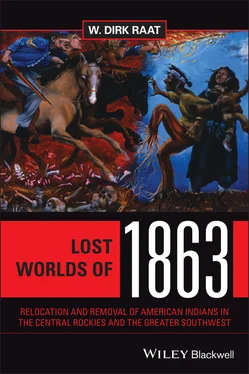1 ...7 8 9 11 12 13 ...29 While the 1863 Emancipation Proclamation remains a significant document, the question remains, why was it so silent concerning the American Indian? And, more generally, what was the Indian policy of the Great Emancipator? Certainly, he must have known about some of the traditions of Indian slavery, and that the institution of slavery dehumanized Indians as well as Afro-Americans; and what about his contemporary, the Great Pathfinder and Republican Free-Soiler John C. Frémont? If his voice rang so loudly for curtailing the expansion of slavery into the western territories, why was it rumored that he held several de facto Indian slaves and peons at his Mariposa estate in California? These and other questions will be treated in this chapter, beginning with the history of Indian slavery in the United States.
Indian Slavery and the Slave Trade, Particularly in the Southwest Borderlands
Contrary to popular belief, American Indians were enslaved by each other and their European conquerors. In other words, the history of slavery in the United States includes slavery by Native Americans as well as slavery of Native Americans. The slavery practiced by indigenous groups prior to the European introduction of African slaves was a limited type of slavery that held people in servitude to work off a debt or serve a penal sentence. It is often called “de facto” slavery or “peonage.” Sometimes, as in the case of the Aztecs, slaves were used for ritual sacrifices. Slavery was often the result of “blood” revenge practices between extended families, clans, and tribes, and most of these slaves were war captives. Kinship and community overlapped with slavery, with captives (Indian and non-Indian) often being slowly integrated into the tribe. Unlike the chattel slavery of the Europeans and Americans, slaves were not simply property (commodities, credit, or assets to secure loans, capital, and investments), and slavery usually was not accompanied by sexism (although women and children were most often the victims) and racism.
In North America, several tribes held captives as hostages for payment (pawnage) or imposed slavery on tribal members who committed crimes. The Creeks of Georgia and the Comanches of Texas were notorious “slavers” and slave traders, the Comanches often trading Sioux, Navajo, and Apache women and children to Mexicans as slave laborers and domestic servants. Fishing villages like the Yurok of northern California were acknowledged slaveholders. The Haida and Tlingit were traditionally known as fierce warriors and slave traders, and in the Pacific Northwest as many as one-fourth of the indigenous populations were slaves. 6By the early nineteenth century Indian slavery and the slave trade extended from the Great Lakes and Canada through the Greater Southwest, including southern California.
By the beginning of the nineteenth century one of the more established slave trade routes ran from the Los Angeles area in southern California, through the Mojave district on the Colorado River, on to Zuni or Durango, to the Spanish community of Santa Fé. This had been an Indian trading trail in the pre-Spanish Southwest. At the end of the Spanish colonial era it involved Ute Indians capturing Paiutes or purchasing Paiute children from their parents, and trading them to the Mojaves for horses from California and Sonora. The Mojaves would exchange their captives at markets in northern Mexico and Alta California. Some of the horses and Paiute slaves would also be exchanged for Navajo blankets, ceramics, and buffalo skins from Santa Fé. Horses that sold for $10 each in California might fetch as much as $500 in Missouri, while young female Paiutes could bring as much as $250 in the Santa Fé market. The Utes practically depopulated Nevada and Utah of their Paiute population, with any remaining Paiutes, or “Diggers” as the locals called them, enslaved by first the Mountain Men and trappers, and later Mormon settlers. All had access to the slave trade along the Old Spanish Trail. 7
Indian and African slavery was always a tool of European expansion. To depopulate the Carolinas and Florida of their original inhabitants in order to introduce plantation agriculture (along with the international market for commodities and labor), English and American settlers and their Indian allies captured hundreds of Indians and forced their removal from their native lands. This was accompanied by violence, rape, and warfare. From 1670 to 1720 more Indians were exported out of Charleston, South Carolina, than Africans were imported as slaves—even though Charleston was a major port city for African slaves. The Choctaws and their neighbors in the Lower Mississippi Valley, battered by raiders spent most of their lives working on plantations in the West Indies. 8
One peculiarity of American history was the possession of African slaves by Native Americans. From the early times of colonial America Indian slaves, African slaves, and European indentured servants all lived and worked together. Over time many of the Native Americans became partially assimilated and absorbed many aspects of white European–American culture, including the “peculiar institution” of African chattel slavery.
While the practice was limited in the American Southwest, 9the Indians of “cotton culture” country held the most enslaved blacks. This was especially true for the so-called “Five Civilized Tribes” of the Southeast, especially the Cherokees who by 1809 held 600 enslaved blacks, a number that grew to 21,000 in 1860. The Cherokee constitution, written by the Indians themselves, prohibited slaves and their descendants (including mixed-races) from owning property. When the Indian Removal Act was enforced during the 1830s, the Cherokees, Choctaws, Chickasaws, Creeks, and Seminoles took their slaves (6% of the aggregate population, or 5,000 black slaves) with them to Indian Territory (today’s Oklahoma), and later supported the Confederate cause during the Civil War. 10
By the middle of the nineteenth century Indian slavery in the Southwest was a mix of three distinct traditions. The first, of course, was the kin-ordered system of the Native Americans themselves. The second was an amalgam of Indian and Spanish practices, and was not unlike the kin-based slave societies of Africa. This borderland “slave system” paralleled the African situation in several ways, including war captives, the dominance of women and children as slaves, the absence of plantations, the practice of pawnage, the role of kinship and related customs (including, for the Spanish, compadrazgo sanctified by the Church, and other kinds of social interchange that extended family relations such as intermarriage, concubinage, and miscegenation), and the agency of a “conquest” state that curtailed or promoted slavery. 11
Finally, of course, the chattel slavery that was introduced to America by Europeans and promoted in the Southwest by Anglo-Americans. Chattel slaves, unlike land or buildings, were simply movable pieces of property. This third system, while part of an international economy that did not always penetrate the borderlands, did share with the Spanish tradition the custom of discrimination (most Indians, especially the “wild” ones, were savages) and a belief in the slaveholder group of cultural and religious superiority. Racism, especially dark skin color denoting racial inferiority, and sexism were more prevalent among white Americans than Spaniards and Mexicans.
The European trade in Indian slaves was initiated by Columbus in 1493. Following the Italian mercantile tradition of the trading company ( compañía) , a small group of passive, wealthy individuals would invest in a venture in which the active partners would be shareholders. The gold seekers and/or slave traders would receive a share in the gold and/or slaves that were found or captured. Needing funds to support his New World adventures, Columbus shipped Indians to Spain where there existed a slave market that sold Africans and Muslims. The entrada or entry by slave raiders into the Caribbean followed this basic form. When the original inhabitants of the West Indies died out due to disease, warfare, and slavery, this mercantile tradition was carried to the Indian communities of Central America (about 650,000 Indians in coastal Central America were enslaved in the sixteenth century) and fringe regions south and north of central Mexico. 12
Читать дальше












